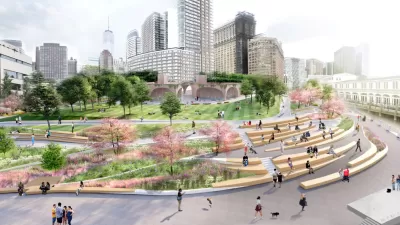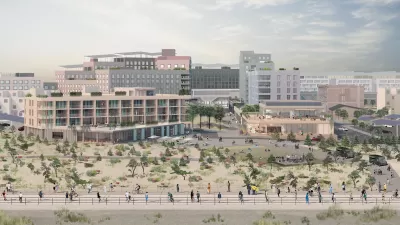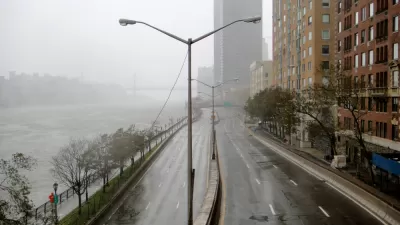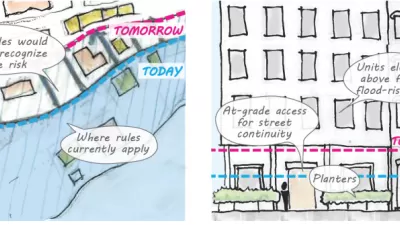A massive project underway in Lower Manhattan seeks to protect the shoreline from future flooding and mitigate the effects of climate change and rising sea levels.

Writing in Bloomberg CityLab, Patrick Sisson reports on efforts to protect Battery Park City from catastrophic flooding like the kind that devastated parts of New York during Hurricane Sandy. As Sisson writes, local residents want authorities to remember that “amid the high-rises, there’s a real neighborhood here in this low-lying area at the southern tip of Manhattan, with roughly 16,000 full-time residents and its own Little League.”
Now, the Battery Park City Resiliency Project is working to prevent similar floods and bolster the coastline against future threats. “With global design firm AECOM working as lead architect and engineer, the project amounts to a wholesale reconstruction of the already artificial Battery Park City — 92 acres created from soil and rock dug during the construction of the World Trade Center.”
The project is part of the Lower Manhattan Coastal Resiliency plan, a broader effort to protect the city in the wake of Hurricane Sandy. The article describes the various approaches that will be taken to address flood risks in different areas of the shoreline, with many of them doubling as public parks and amenities. Some areas will be protected by flood walls, while others will be built to withstand flooding with water-resistant materials and plants that can survive being submerged.
“The project is a rare exception, in many ways. The Battery Park City Authority can leverage bond funding and coordinate the endeavor in ways other local government entities can’t. It’s an example of an empowered local government entity in a wealthy neighborhood tackling rising water with immense financial resources.” But while not all communities may have the resources the Battery Park City Authority does, the project holds lessons for other climate resilience projects. “Ideally, [Thad Pawlowski, a professor and managing director at Columbia University’s Center for Resilient Cities and Landscapes] sees this raising the standard, and helping other neighborhoods — such as Red Hook in Brooklyn or Hunt’s Point in the Bronx, which don’t have Battery Park City’s resources and face some of the highest risks from climate change — demand and receive more.”
FULL STORY: Behind a Billion-Dollar Bid to Save Lower Manhattan

Study: Maui’s Plan to Convert Vacation Rentals to Long-Term Housing Could Cause Nearly $1 Billion Economic Loss
The plan would reduce visitor accommodation by 25,% resulting in 1,900 jobs lost.

North Texas Transit Leaders Tout Benefits of TOD for Growing Region
At a summit focused on transit-oriented development, policymakers discussed how North Texas’ expanded light rail system can serve as a tool for economic growth.

Why Should We Subsidize Public Transportation?
Many public transit agencies face financial stress due to rising costs, declining fare revenue, and declining subsidies. Transit advocates must provide a strong business case for increasing public transit funding.

Dear Tesla Driver: “It’s not You, It’s Him.”
Amidst a booming bumper sticker industry, one writer offers solace to those asking, “Does this car make me look fascist?”

A Visual Celebration of Manhattan’s Chinatown Elder Community, Through Food
Lanterns, cafeteria trays, and community connection take center stage in this stunning photo essay.

How to Make US Trains Faster
Changes to boarding platforms and a switch to electric trains could improve U.S. passenger rail service without the added cost of high-speed rail.
Urban Design for Planners 1: Software Tools
This six-course series explores essential urban design concepts using open source software and equips planners with the tools they need to participate fully in the urban design process.
Planning for Universal Design
Learn the tools for implementing Universal Design in planning regulations.
City of Santa Clarita
Ascent Environmental
Institute for Housing and Urban Development Studies (IHS)
City of Grandview
Harvard GSD Executive Education
Toledo-Lucas County Plan Commissions
Salt Lake City
NYU Wagner Graduate School of Public Service





























